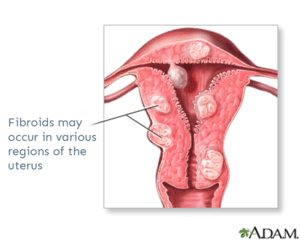
Fibroids 101: What You Need to Know
Have you been told that you have a fibroid? If so, hearing this may sound scary if you don’t know much about fibroids. However, we hope that we can help put your mind at ease as you learn more about them.
What is a fibroid?
The uterus (womb) is made of muscle. This gives it the ability to contract when a woman is in labor to help deliver her baby. When the muscle cells continue to reproduce, it creates an overgrowth of cells in one area, this is called a uterine fibroid. Uterine fibroids are also referred to as myomas or leiomyomas. According to John Hopkins Medicine, 20-70% of reproductive age women develop fibroids and 99% of the time they are harmless.
What does a fibroid look like?
Just like every woman is different, every fibroid is different. Fibroids come in a variety of sizes and can be smaller than a pea or or as large as a grapefruit. Fibroids can grow within the uterine cavity, be completely contained within the wall of the uterus, or can grow on the outside surface of the uterus. They can even be connected to the uterus with a stalk and are then called a pedunculated fibroid. They are typically round growths but their shapes can also vary.
Are fibroids cancerous?
Fibroids are NOT cancerous. They are what are referred to as benign tumors, or growths of tissue that do not spread (or metastasize) to distant sites. So just take a deep breath. Although it is important to understand what a fibroid is, you can rest assured that it is not cancer.
What causes fibroids?
We don’t fully understand what causes fibroids to form.
What symptoms are caused by fibroids?
Fibroids may cause no symptoms at all. However, some women do have symptoms from their fibroid or fibroids. Symptoms depend upon the location of the fibroid (is it within the uterine cavity or within the muscle wall?), the size of the fibroid, and each individual woman. Some common symptoms of fibroids include:
- Heavy and/or irregular menstruation
- Irregular vaginal bleeding or spotting
- Painful intercourse
- Anemia due to blood loss
- Dysmenorrhea (painful menstruation)
When fibroids become large they can cause pressure symptoms in the pelvis or abdomen, and if they are positioned where they push on a woman’s bladder, they may cause urinary frequency or urgency. Large fibroids can also cause pressure symptoms due to the amount of space they take up within the pelvis, pushing other organs out of the way. Fibroids can sometimes cause pain if they grow rapidly or are on a stalk that twists, cutting off blood supply. In some cases, they may even cause problems with fertility or miscarriages.
Although uterine fibroids are not cancerous, occasionally they can be associated with another type of cancer. For this reason, if you notice a change in your symptoms, you would want to reach out and check-in with your Diana Health provider or other health practitioner.
Does my fibroid need to be treated?
Some women live their entire life with a fibroid or multiple fibroids, and never even know it. That is because many fibroids do not cause any symptoms. They are sometimes found incidentally when a woman has imaging of her pelvis such as during an ultrasound or MRI for an unrelated issue. Fibroids only need treatment if they are causing problems for you that become bothersome enough to require treatment. This is something that you can discuss with your Diana Health care professional.
How are fibroids diagnosed?
When your healthcare practitioner does a pelvic exam, they usually put a couple globed fingers inside the vagina and then feel the top of the uterus with their other hand that is on top of the pelvis. This allows them to sense how large the uterus is and sometimes they may be able to suspect that a woman has a fibroid if her uterus feels larger than normal or is abnormal in size or firmness. If a healthcare practitioner suspects a uterine fibroid is causing problems (such as pressure or abnormal bleeding), they often order a pelvic ultrasound so that they can see how large the fibroid is, whether or not there are multiple fibroids, and where the fibroid(s) are located. Sometimes fibroids inside of the uterus that make the inner wall of the uterus bulge are found during a hysterosalpingogram, hysteroscopy, or sonohysteroscopy which all involve looking at the inside lining of the uterus through imaging or radiographically. They may also be found during a laparoscopy, when a doctor is looking in the abdomen and pelvis with a small camera and light placed inside of the abdomen and pelvis through very small incisions.
I have a fibroid and my healthcare practitioner thinks it is causing my symptoms, now what?
If you have a fibroid that is the cause of bothersome symptoms, it is time for a conversation with your provider and shared decision making. Even if you have a uterine fibroid and irregular bleeding, it doesn’t necessarily mean that the irregular bleeding is definitely caused by the fibroid. It depends on its location, size, and other factors. Your provider may suggest treatment with medication, surgery to remove the fibroid or even potentially the entire uterus if you do not wish to carry a baby within your uterus in the future.
Sometimes IUDs (intrauterine devices) can also be used to treat the symptoms of a fibroid. There are also options such as uterine artery embolization where the blood supply to a fibroid can be blocked off, hopefully causing the fibroid to stop causing bothersome symptoms. There are other procedures such as radiofrequency ablation that are sometimes used too. Shared decision making is important because the risks and potential benefits for each intervention are different, just as your body and your fibroid(s) differ from those of other women.
Do fibroids change with menopause?
Often women with symptomatic fibroids have a decrease in fibroid symptoms after going through menopause (one year after the cessation of menstruation/periods). This happens due to a change in hormone levels that come with menopause. Some women with mildly bothersome fibroid symptoms, especially if they are close to menopause, may decide to wait and see if and how their symptoms change with menopause, rather than undergoing medical or surgical treatment.
Because of the variety of types and sizes of fibroids, as well as the various symptoms they can cause, learning about fibroids may still leave you confused. In addition to reading more about fibroids from reputable sources such as the American College of Obstetricians and Gynecologists, we want you to know that we, at Diana Health, are here to help you. We want to hear about YOUR symptoms, what is bothering YOU and how YOU feel. Through listening, a thorough examination, and imaging of your uterus if indicated, we will engage in shared decision making with you so that you can move in the direction that is best for you and your body. You can book a visit with us online or by calling your local Diana Health practice, if you suspect you may have a fibroid or if something just feels off.

Share This Post
























